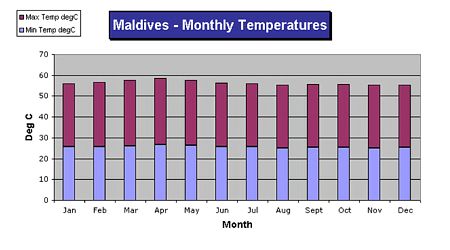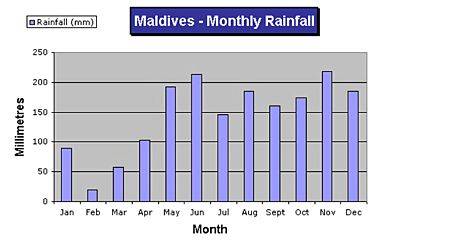In a nation that is more sea than land (less than one per cent of the Maldives is land), the weather obviously plays a significant role in day to day life. Since earliest times, the Maldivian people have organized their lives around a calendar of nakaiy - a series of 13 or 14 day intervals, each with a predictable weather pattern.Every year brings two monsoons, iruvai (the north-east monsoon) and hulhangu (the south-west monsoon). To a visitor, this simply means the hot and dry season (iruvai) and the hot and west season (huhangu).
| Iruvai |
| Dec 10 – Dec 22 | Mula | Strong winds, rough seas. Fishing in the north is good |
| Dec 23 – Jan 5 | Furahalha | Strong north easterly winds, rough seas. A good fishing season in the north |
| Jan 6 – Jan 18 | Uthurahalha | Clear blue skies, strong winds and rough seas |
| Jan 19 – Jan 31 | Huvan | Calm seas, blue skies. Fishing in the east is good. |
| Feb 1 – Feb 13 | Dhinasha | North-easterly winds, moderate seas, plenty of sunshine |
| Feb 14 – Feb 26 | Hiyaviha | Seas are calm, days and nights are hot. |
| Feb 27 – Mar 11 | Furabadhuruva | Frequent, short sharp bursts of thunder and lightning. Small plants and bushes are cut down, left to dry and then burnt |
| Mar 12 – Mar 25 | Fasbadhuruva | Usually clear blue skies. If thunder is frequent during this period, local lore says the yam harvest will be good for the year |
| Mar 26 – Apr 7 | Reyva | If storms occur they may be severe. Fishing is good in the north. Some trees are cut down and burnt. |
| Hulhangu |
| Apr 8 – Apr 21 | Assidha | Begins with a storm, then becomes hot and dry. People allow themselves to be wet by the first rains, believing it will bring them good luck. Fishing is poor, millet and trees are planted. |
| Apr 22 – May 5 | Burunu | Begins with a storm and strong winds, then becomes calm. Fields are cleared, trees chopped and seeds sown. |
| May 6 – May 19 | Kethi | Dark clouds, frequent rains. Dried leaves are burnt and the ashes spread over the fields. Sowing continues. |
| May 20 – Jun 2 | Roanu | Storms, strong winds and rough seas. Fields are sown on some islands during this period |
| Jun 3 – Jun 16 | Miyahelia | Storms, rough seas and strong westerly winds. Fields are sown and weeded. |
| Jun 17 – Jun 30 | Adha | South westerly winds, light rain and schools of fish. Fields are weeded and transplanted. |
| Jul 1 – Jul 14 | Funoas | Storms and rough seas with frequent sudden gales. Weeding and transplanting continues. |
| Jul 15 – Jul 28 | Fus | Wet and overcast. Fishing is good. |
| Jul 29 – Aug 10 | Ahuliha | Less Frequent storms, calmer days. Grain harvests are reaped. |
| Aug 11 – Aug 23 | Maa | Generally calm. Harvesting continues. |
| Aug 24 – Sept 6 | Fura | Isolated showers, usually dry with light north westerly winds. Harvesting continues. |
| Sep 7 – Sep 20 | Uthura | Strong north westerly winds, isolated showers |
| Sept 21 – Oct 3 | Atha | Generally clear and calm with isolated showers |
| Oct 4 – Oct 17 | Hitha | Light winds and isolated showers |
| Oct 18 – Oct 30 | Hey | Strong winds from all directions.Fishing is excellent and the markets are filled with large tuna. |
| Nov 1 – Nov 13 | Viha | Calm days. Fishing is good. |
| Nov 14 – Nov 26 | Nora | Light winds, some sun showers. Sea current are unsettled as the north-east monsoon approaches |
| Nov 27 – Dec 9 | Dosha | Light north-easterly winds. Good fishing. |
| In tourist jargon, the seasons are described as ‘high’ and ‘low’. From November through to April, tourists flock to the islands to enjoy clear blue skies and tropical sunshine. From May until October, the weather can be temperamental – a mixed bag of sunshine, showers and storms – and tourist prices are slashed to entice visitors in spite of the weather. |
| Year round the temperature rarely falls below 25degC most often settling around 30degC. 
Annual rainfall is approximately 1750mm with monthly figures as shown in the graph below 
|